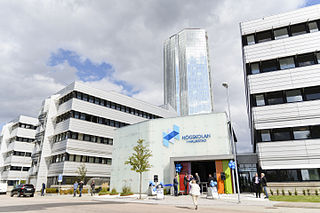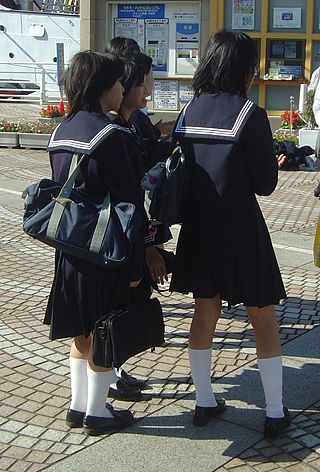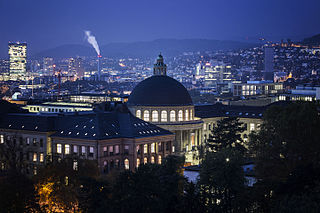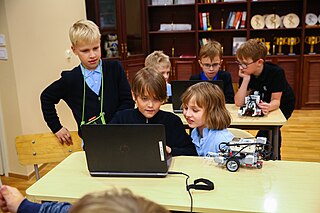The University of Brighton is a public university based on four campuses in Brighton and Eastbourne on the south coast of England. Its roots can be traced back to 1858 when the Brighton School of Art was opened in the Royal Pavilion. It achieved university status in 1992.
Science education is the teaching and learning of science to school children, college students, or adults within the general public. The field of science education includes work in science content, science process, some social science, and some teaching pedagogy. The standards for science education provide expectations for the development of understanding for students through the entire course of their K-12 education and beyond. The traditional subjects included in the standards are physical, life, earth, space, and human sciences.

Halmstad University is a university college in Halmstad, Sweden. It was established in 1983. Halmstad University is a public higher education institution offering bachelor's and master's programmes in various fields of studies. In addition, it conducts PhD programmes in the three fields Information Technology, Innovation Science, and Health and Lifestyle.
A Bachelor of Education is an undergraduate academic degree which prepares students for work as a teacher in schools. A Bachelor of Education program typically lasts three to four years and combines both coursework and practical experience in educational settings. The curriculum is designed to provide foundational knowledge in pedagogy, educational psychology, teaching methodologies, and subject-specific training. Graduates of this program are equipped with the skills necessary to foster a supportive and effective learning environment for their students.

Secondary education in Japan is split into junior high schools, which cover the seventh through ninth grade, and senior high schools, which mostly cover grades ten through twelve.

In France, secondary education is in two stages:

The Illinois Mathematics and Science Academy, or IMSA, is a three-year residential public secondary education institution in Aurora, Illinois, United States, with an enrollment of approximately 650 students.
Education in Vietnam is a state-run system of public and private education run by the Ministry of Education and Training. It is divided into five levels: preschool, primary school, secondary school, high school, and higher education. Formal education consists of twelve years of basic education. Basic education consists of five years of primary education, four years of secondary education, and three years of high school education. The majority of basic education students are enrolled on a daily basis. The main goals are general knowledge improvement, human resources training and talent development.
The educational system in Taiwan is the responsibility of the Ministry of Education. The system produces pupils with some of the highest test scores in the world, especially in mathematics and science. Former president Ma Ying-jeou announced in January 2011 that the government would begin the phased implementation of a twelve-year compulsory education program by 2014.

The education system in Switzerland is very diverse, because the constitution of Switzerland delegates the authority for the school system mainly to the cantons. The Swiss constitution sets the foundations, namely that primary school is obligatory for every child and is free in state schools and that the confederation can run or support universities.

The University of Chicago Laboratory Schools is a private, co-educational, day Pre-school and K-12 school in Chicago, Illinois. It is affiliated with the University of Chicago. Almost half of the students have a parent who is on the faculty or staff of the university.
Physics education or physics teaching refers to the education methods currently used to teach physics. The occupation is called physics educator or physics teacher. Physics education research refers to an area of pedagogical research that seeks to improve those methods. Historically, physics has been taught at the high school and college level primarily by the lecture method together with laboratory exercises aimed at verifying concepts taught in the lectures. These concepts are better understood when lectures are accompanied with demonstration, hand-on experiments, and questions that require students to ponder what will happen in an experiment and why. Students who participate in active learning for example with hands-on experiments learn through self-discovery. By trial and error they learn to change their preconceptions about phenomena in physics and discover the underlying concepts. Physics education is part of the broader area of science education.

Dutchtown High School is a 5A school that was completed in 2003 in Geismar, an unincorporated area of Ascension Parish located in the U.S. state of Louisiana. It is within the Ascension Parish School Board. Dutchtown Middle and Bluff Middle Schools feed into Dutchtown High. The architecture is based on that of the old Dutchtown High, which was situated across the highway at the current Dutchtown Middle School.
Biotechnology High School (BTHS), or commonly referred to as Biotech, is a four-year comprehensive vocational public high school serving students in ninth through twelfth grades in Freehold Township, Monmouth County, in the U.S. state of New Jersey, as part of the Monmouth County Vocational School District (MCVSD). Its curriculum includes a science program, consisting of eight different science classes spread over four years, designed to prepare students to pursue further education in biotechnology and the natural sciences. Emphasis is placed on research, laboratory skills, critical thinking, problem solving, technology, and teamwork. Over 90% of the 2009 graduates selected college majors in the life sciences. The school has been accredited by the Middle States Association of Colleges and Schools Commission on Elementary and Secondary Schools since 2005.
The Professional Graduate Diploma in Education (PGDE) is a one-year postgraduate course for prospective teachers in Scotland. Successful completion of this course allows an individual to teach in a Scottish state school. All PGDE courses at each University are regulated by the Scottish Government and General Teaching Council for Scotland A PGDE is one of the two main routes for entering the teaching profession in Scotland, the other being a 4-year MA/BA Education course.

Opelika City Schools (OCS) is a school district headquartered in Opelika, Alabama. The district is accredited by the Alabama State Department of Education and the Southern Association of Colleges and Schools. The school system enrolls approximately 4,300 students on nine campuses. Opelika has three primary schools with grades K–2, Southview, Jeter, and Carver, three intermediate schools with grades 3–5, West Forest, Northside, and Morris Avenue, Opelika Middle School with grades 6–8, Opelika High School with grades 9–12, and one at-risk school, Opelika Learning Center. Opelika's schools have traditionally had strong programs in technology and the arts.

Computer science education or computing education is the field of teaching and learning the discipline of computer science, and computational thinking. The field of computer science education encompasses a wide range of topics, from basic programming skills to advanced algorithm design and data analysis. It is a rapidly growing field that is essential to preparing students for careers in the technology industry and other fields that require computational skills.
Poughkeepsie High School is the public high school in the city of Poughkeepsie, New York. It is categorized as an inner city school district as a result of the high percentage of students living in low-income households. In the 2014-2015 school year, 73% of students were eligible for free or reduced-price lunch. PHS did not meet the Adequate Yearly Progress (AYP) specified by the No Child Left Behind Act in 2011-12. Poughkeepsie High School is currently the only 9-12 school within the Poughkeepsie City School District.
Pacita Complex National High School (PCNHS), also known as Pacita NHS, is a public secondary high school in San Pedro, Laguna, in the Philippines. It was founded on 13 November 1997, began offering education in 1999, and now runs a curriculum in science, technology, and engineering program and secondary basic education.

National University is a private university headquartered in San Diego, California, United States. Founded in 1971, National University offers academic degree programs at campuses throughout California, a satellite campus in Nevada, and various programs online. Programs at National University are designed for adult learners. On-campus classes are typically blended learning courses, concentrated to four weeks or on weeknights with occasional Saturday classes. The university uses asynchronous learning and real-time virtual classrooms for its online programs.











